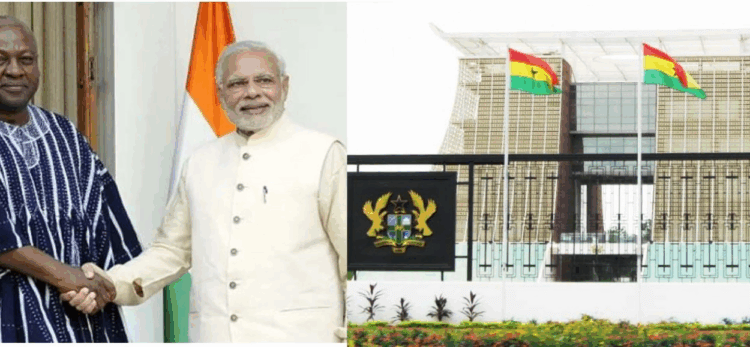The iconic structure housing Ghana’s seat of government is expected to be yet another spotlight for India-Ghana relations as President John Dramani Mahama prepares to host his counterpart, Indian Prime Minister Narendra Modi, for a two-day official visit to Ghana from Wednesday, July 2, to Thursday, July 3, 2025, the Presidency has announced.
This landmark visit marks the first official trip by an Indian prime minister to Ghana in recent years and reflects the deepening strategic partnership between the two nations.
A subtle piece of art giving a colourful blend to the celebration of longstanding relations between both nations is the infrastructure housing the seat of government – the Golden Jubilee House, which was constructed with the support of the Indian people.
A brief history of the Golden Jubilee House
The Flagstaff House was reconstructed and inaugurated by the government with the name Golden Jubilee House in November 2008, funded by the Exim Bank of India through the Government of India LOC for an amount of $84.84 million USD.
The name Flagstaff House, which was given to the building by the British Gold Coast government, glorifies Ghana’s Gold Coast past.
The main office complex resembles a traditional seat, important in Ghana’s folklore, and the Kwame Nkrumah mausoleum, built for the country’s first president, represents a tree cut off in its prime.
There is, quite simply, no other building on earth like Accra’s new-ish presidential palace and seat of the government, Flagstaff House (formerly Golden Jubilee House).
The unique architecture is said to be based on the sacred Asante Golden Stool, emblematic of the birth of the kingdom. The Jubilee House, built in 2007 by the Second President of the Fourth Republic, John Agyekum Kufuor, was the first presidential palace built by an independent Ghana to serve, expressly, as the official seat of the Ghanaian presidency.
The earlier Flagship House was the residence of not only the colonial military officer commanding the West African Frontier Force in the British West African colonies of Ghana, Niger, Sierra Leone and Gambia, but also the residence of the commander of Ghana’s military and Christianborg Castle.
Prior to the construction of the Jubilee House, most of Ghana’s national leaders lived and worked at the Christiansborg Castle at Osu, Accra.
About the Indian community in Ghana
According to the official data from the Indian High Commission in Ghana, the country is home to a vibrant and steadily growing Indian community, estimated to number over 15,000 individuals.
Their presence in Ghana spans over seven decades, with some families now in their fourth generation on Ghanaian soil, many of whom have seamlessly integrated and acquired Ghanaian citizenship.
This long-standing presence, coupled with a more recent influx of Indian expatriates working for multinational corporations and prominent local Ghanaian businesses as skilled professionals, paints a dynamic picture of a community deeply interwoven with the fabric of Ghanaian society.
Indians are highly respected and widely accepted in Ghana, a testament to their contributions and peaceful coexistence.
The first significant wave of Indian arrivals in Ghana, then the Gold Coast, dates back to the early to mid-20th century. Most Indians came as traders, merchants, and professionals seeking new opportunities in a rapidly developing British colony.
Their entrepreneurial spirit quickly saw them establish various businesses, primarily in retail and wholesale trading. Over the decades, this initial trickle transformed into a steady stream, driven by familial ties, business prospects, and the welcoming environment Ghana offered.
The size of the community has consistently grown, propelled by both natural increase within established families and continued migration for economic opportunities and skilled employment.
Indeed, some of the biggest names in the steel, pharmaceutical, and other key sectors across Africa are owned and managed by individuals of Indian origin. Prominent examples include B5 Plus Ltd in the steel industry, a major player in Ghana and the wider West African region, and companies like Pharmanova in pharmaceuticals, along with other significant Indian-owned entities such as Melcom Group (retail & wholesale) and Swami India Ghana Ltd (real estate and construction).
These businesses highlight their significant economic footprint and deep investment in Ghana’s industrial landscape.
PM’s Visit
According to a statement signed by Presidential Spokesperson Felix Kwakye Ofosu, the visit underscores the warm and long-standing ties between Ghana and India, and both leaders are expected to use the opportunity to enhance cooperation across a range of sectors.
The agenda for Prime Minister Modi’s visit includes:
A bilateral meeting with President Mahama at the Jubilee House.
High-level discussions on trade, investment, agriculture, education, technology, healthcare and energy.
An exchange of views on regional and global developments of mutual interest.
Bilateral agreements & joint press briefing
One of the key outcomes of the visit will be the signing of several bilateral agreements to expand collaboration frameworks between Accra and New Delhi. These agreements are expected to lay the foundation for increased economic and developmental engagement.
Following the signing ceremony, President Mahama and Prime Minister Modi will address a joint press conference, where further details of their cooperation roadmap will be shared.








